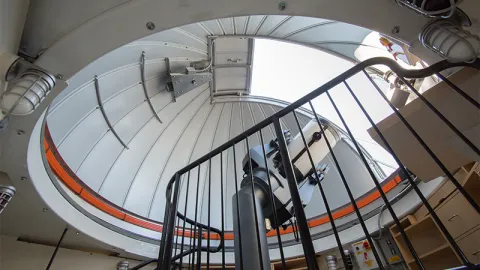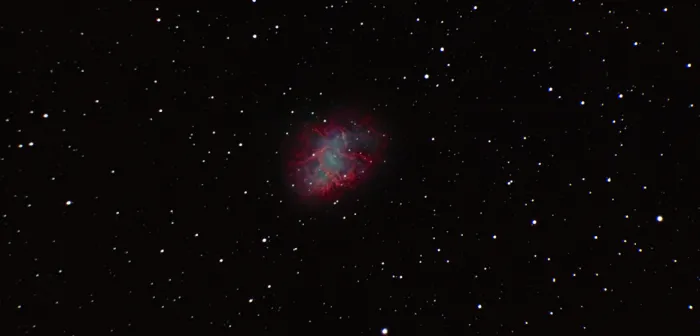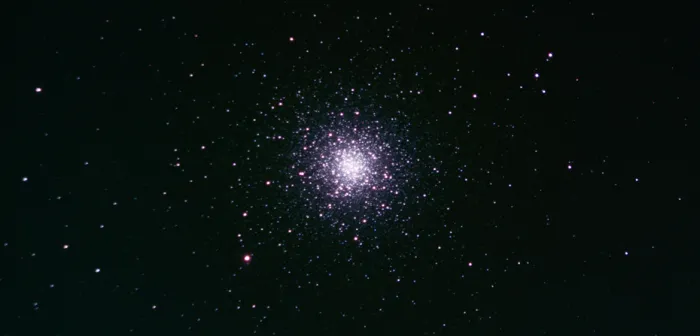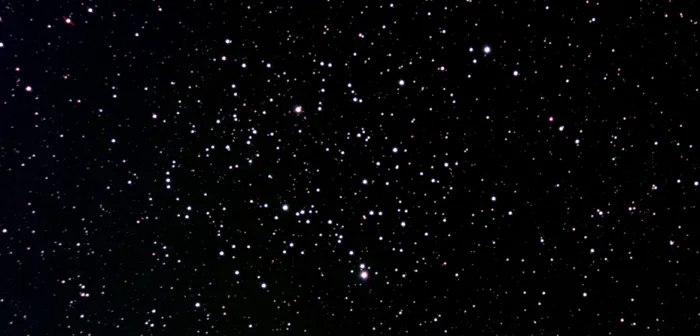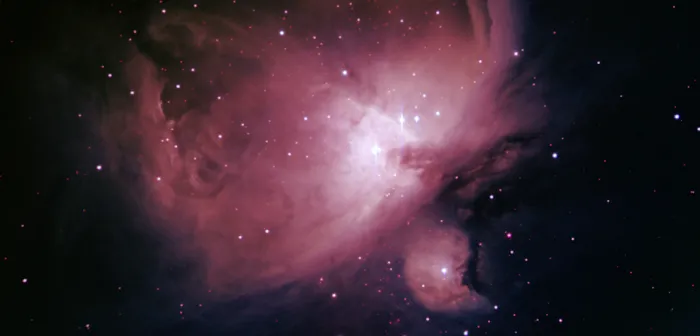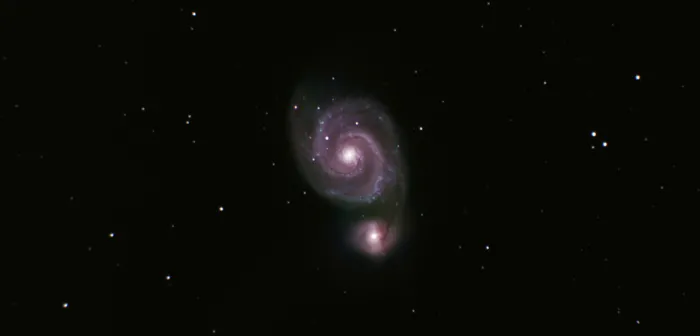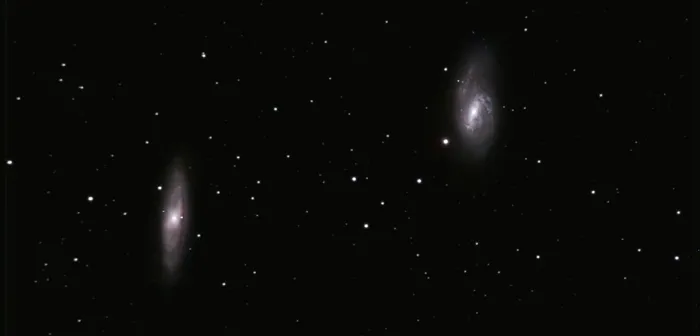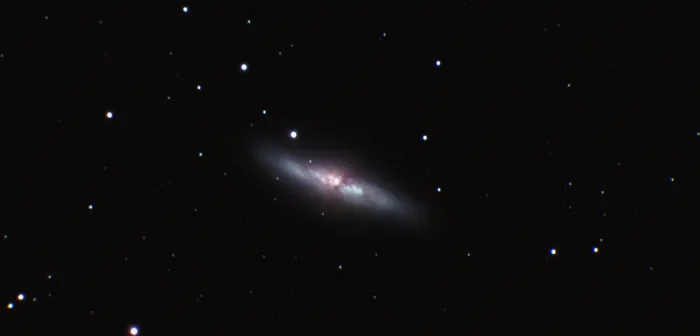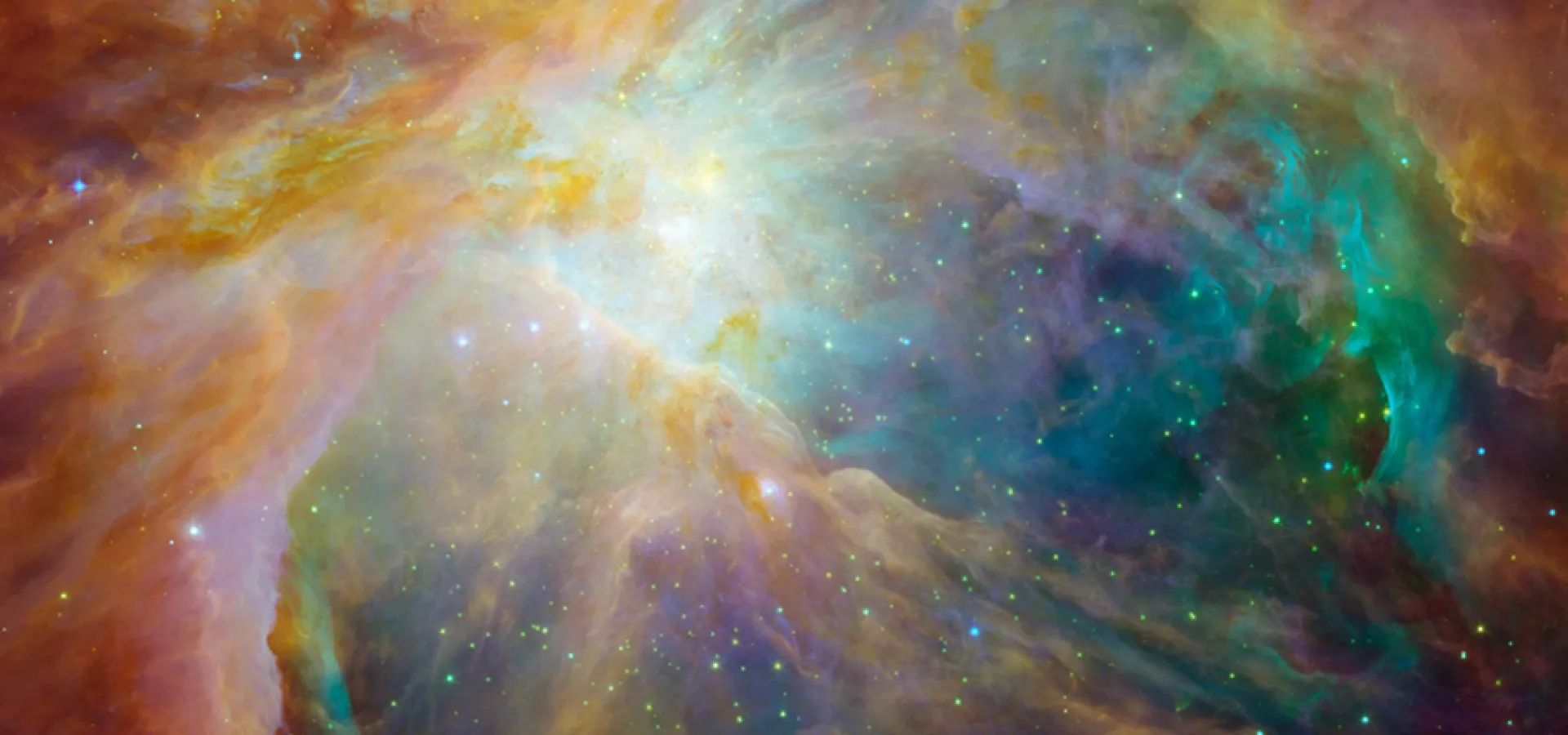
Astronomy
Smith astronomy is a part of the Five College Astronomy Department. The consortium offers a rich curriculum in astronomy and astrophysics, taught by astronomers from Smith, Amherst College, Hampshire College, Mount Holyoke College and the University of Massachusetts. Students who major in astronomy also take courses in physics and often double major in physics and astronomy.
Astronomy is the study of the cosmos, from our home planet to the farthest reaches of the universe. One of the original liberal arts, astronomy offers an unparalleled perspective for appreciating our planet and the life that it supports. It also provides an opportunity to appreciate the simplicity of the forces of nature and understand how these forces govern the origin and evolution of our universe.
Requirements & Courses
Goals for Majors in Astronomy
- Be an active learner/researcher; be able to recognize and define important questions and know how to go about finding the answers.
- Be familiar with basic concepts from physics and astronomy, including gravity, the nature of light and physical characteristics of matter, and be able to use them as the basis for critical reasoning.
- Be skilled at quantitative problem solving incorporating hypothesis formation, data analysis, error analysis, conceptual modeling, numerical computation and hypothesis testing through quantitative comparison between observation and theoretical concepts.
- Be familiar with scientific instrumentation used by professional astronomers.
- Be familiar with digital imaging as a source of scientific data, including techniques of acquisition, reduction and analysis.
- Demonstrate use of critical thinking skills in well-organized, logical and scientifically sound oral and written scientific reports.
- Be able to critically evaluate representations of science in the media, both in writing and in speaking.
- Be able to communicate science effectively to the general public and the media.
- Be aware of and prepared for the variety of opportunities and career paths that are open to students who have majored in astronomy.
Astronomy Major
The astronomy major provides a good foundation in modern science with a focus on astronomy. Taken alone, it is suited for students who wish to apply scientific training in a broad general context. If coupled with a major in physics, the astronomy major or minor provides the foundation to pursue a career as a professional astronomer. Advanced courses in mathematics and a facility in computer programming are strongly encouraged.
Requirements
Eleven courses (44 credits)
- AST 100 or AST 111
- AST 113
- AST 235
- Two courses at the 200 level
- One course at the 300 level
- PHY 117 and PHY 118
- Three courses at the 200 or 300 level
Students with especially strong background in physics or astronomy may, in consultation with their advisers, replace AST 111 with a more advanced course. Up to two of the three courses at the 200 or 300 level may, after consultation with and approval by the major advisor, be selected from 200- or 300-level courses in a related discipline such as mathematics, physics, geology, computer science or the history or philosophy of science.
Astronomy Minor
The minor provides a practical introduction to modern astronomy. If combined with a major in another science or mathematics related field, such as geology, chemistry or computer science, it can provide a versatile scientific background that would prepare a student for future work as a scientist or technical specialist. Alternatively, the minor may be combined with a major in a nonscientific field, such as history, philosophy or education, for students who wish to apply their astronomical backgrounds in a broader context, which could include history of science, scientific writing or editing, or science education.
Requirements
Six courses (24 credits)
- AST 100 or AST 111
- One course at the 200 level
- PHY 117
- Two astronomy courses
- One course in astronomy or physics
Astrophysics Minor
The astrophysics minor is an alternate option for the student who is considering a career as a professional astronomer. Central to this approach is a strong physics background, coupled with an exposure to topics in modern astrophysics. Students are advised to acquire a facility in computer programming. Especially well-prepared students may enroll in graduate courses in the Five College Astronomy Department.
Requirements
Completion of physics major plus any three astronomy classes except AST 100, AST 102, AST 103 and AST 111.
Courses
Good choices for first-year astronomy courses for science majors are AST 111 and AST 113. Courses designed for nonscience majors who would like to know something about the universe are AST 100, AST 102 and AST 103.
AST 100 A Survey of the Universe (4 Credits)
Discover how the forces of nature shape our understanding of the cosmos. Explore the origin, structure and evolution of the Earth, moons and planets, comets and asteroids, the Sun and other stars, star clusters, the Milky Way and other galaxies, clusters of galaxies, and the universe as a whole. Designed for nonscience majors. Enrollment limited to 50. {N}
Fall
AST 102 Sky and Time (4 Credits)
This course explores the astronomical roots of clocks and calendars, and relies on both real and simulated observations of the Sun, Moon and stars. In addition to completing weekly projects based on collecting and interpreting data, students independently research a clock and a calendar from another culture, either ancient or modern. There are no prerequisites, and students from all disciplines and backgrounds are welcome. Enrollment limited to 25. {N}
Spring
AST 103 Sky and Telescopes (3 Credits)
Discover how astronomers know about the universe by observing the light that comes to us from distant objects. View the sky with your naked eye, binoculars, and a small telescope. Take pictures with a professional telescope, and examine astronomical images. Designed for non-science majors. Enrollment limited to 20. {N}
Fall
AST 104 Alien Worlds (4 Credits)
This course explores the study and search for extraterrestrial worlds. Students examine in detail our own solar system, the formation and evolution of planets, planets outside of our solar system (known as exoplanets) and the architecture of planetary systems. This course investigates the detection techniques developed by astronomers to discover and characterize exoplanets. Questions of what makes a planet habitable, the possibility for extraterrestrial life and the potential for the discovery of extraterrestrial life in the future are explored. This course examines how science works, emphasizing that science is a dynamic process and not just a set of facts. {N}
Fall, Spring, Variable
AST 111 Introduction to Astronomy (4 Credits)
A comprehensive introduction to the study of modern astronomy, covering planets their origins, orbits, interiors, surfaces and atmospheres; stars their formation, structure and evolution; and the universe its origin, large-scale structure and ultimate destiny. This introductory course is for students who are planning to major in science or math. Prerequisite: MTH 111 or equivalent. {N}
Fall
AST 113 Telescopes and Techniques (4 Credits)
An introduction to observational astronomy for students who have taken or are currently taking a physical science class. Become proficient using the telescopes of the McConnell Rooftop observatory to observe celestial objects, including the Moon, the Sun, the planets, stars, nebulae and galaxies. Learn celestial coordinate and time-keeping systems. Find out how telescopes and digital cameras work. Take digital images of celestial objects and learn basic techniques of digital image processing. Become familiar with measuring and classification techniques in observational astronomy. Not open to students who have taken AST 103. Enrollment limited to 20. {N}
Spring
AST 214 Astronomy & Public Policy (4 Credits)
This course explores the intersection of physical science, social science, psychology, politics and the environment. How do scientists, decision makers and the public communicate with each other, and how can scientists do better at it? What should the role of scientists be in advocacy and social movements? How does scientific information influence lifestyle and behavior choices among the public at large? The course focuses on three topics with close ties to astronomy: (1) global climate change, which involves basic atmospheric physics; (2) light pollution, which wastes billions of dollars per year and ruins our view of the starry sky without providing the safety it promises; and (3) controversial development of mountaintop observations such as the Thirty Meter Telescope on Mauna Kea, HI. Throughout the course students develop science communication skills using proven techniques borrowed from theater. Prerequisite: one college science course in any field and MTH 111 or the equivalent. {N}{S}
Fall, Spring, Alternate Years
AST 226 Cosmology (4 Credits)
This course begins with the discovery of the expansion of the universe, and moves on to current theories of the expansion. Students consider cosmological models and topics in current astronomy that bear upon them, including the cosmic background radiation, nucleosynthesis, dating methods, determination of the mean density of the universe and the Hubble constant, and tests of gravitational theories. Prerequisites: (AST 100 or AST 111) and MTH 111, or equivalent. {N}
Fall, Spring, Alternate Years
AST 228 Astrophysics I: Stars and Galaxies (4 Credits)
A calculus-based introduction to the properties, structure, formation and evolution of stars and galaxies. The laws of gravity, thermal physics and atomic physics provide a basis for understanding observed properties of stars, interstellar gas and dust. We apply these concepts to develop an understanding of stellar atmospheres, interiors and evolution, the interstellar medium, and the Milky Way and other galaxies. Prerequisites: two semesters of college-level physics and second-semester calculus. {N}
Spring
AST 235 Introduction to Stellar Structure (4 Credits)
A calculus-based introduction to the observations and theoretical understanding of the structure and evolution of stars. Topics include astrometry, photometry, spectroscopy, the Planck function of thermal emission, cause of spectral emission and absorption lines, Boltzmann and Saha distributions of atomic energy levels and ionization states, the Hertzprung Russell diagram, binary stars and stellar mass determination, nuclear energy generation in stars, hydrodynamic equilibrium, equations of state, and the fates of stars. Prerequisites: [(PHY 117 and PHY 118) or PHY 119] and MTH 112. {N}
Fall
AST 337 Observational Techniques in Optical and Infrared Astronomy (4 Credits)
This course provides an introduction to the techniques of gathering and analyzing astronomical data, with an emphasis on optical observations related to studying stellar evolution. Students use Smith’s telescopes and CCD cameras to collect and analyze their own data, using the Python computing language. Topics covered include astronomical coordinate and time systems; telescope design and optics; instrumentation and techniques for imaging and photometry; astronomical detectors; digital image processing tools and techniques; atmospheric phenomena affecting astronomical observations; and error analysis and curve fitting. Prerequisites: at least one of AST 226 or AST 228, and one physics course at the 200-level. Previous experience in computer programming is strongly recommended. {N}
Fall
AST 400 Special Studies (1-4 Credits)
Independent research in astronomy. The student is expected to define their own project and to work independently, under the supervision of a faculty member. Admission by permission of the department.
Fall, Spring
AST 430D Honors Project (4 Credits)
Available to qualified students ready for rigorous independent work. Students are expected to define their research project and work in close consultation with an adviser. Full-year course.
Fall
Additional Programmatic Information
Major and Minor Advisers:
James Lowenthal; Kimbely Ward-Duong
Honors Directors:
James Lowenthal; Kimberly Ward-Duong
Faculty
Emeriti
Suzan Edwards
L. Clark Seelye Professor Emerita of Astronomy
Richard White
Professor Emeritus of Astronomy
McConnell Rooftop Observatory
Image Gallery
Images taken with our 12- and 16-inch telescopes.
Resources
Summer Opportunities
- Smith SURF Program
- Smith Praxis Program
- FCAD Summer Research
- National Science Foundation's Research Experiences for Undergraduates
- NASA Student Employment
- Pathways to Science: Summer Research Experiences for Undergraduates
Career Options in Astronomy
- Career Advice from the American Astronomical Society
- Career Advice on Being an Astronomer from the National Optical Astronomy Observatories
- American Astronomical Society Career Services
- American Institute of Physics Student Programs
- Graduate Programs in Astronomy
- American Association of Physics Teachers Scholarships for Future Teachers
Literature Searches
Tools & Software
- Calculators and Conversions
- A Guide to IDL for Astronomers
- Image Reduction and Analysis Facility (IRAF)
- Flexible Image Transport System (FITS)
- Ned Wright's Cosmology Calculator
- Lionel Siess Homepage, Stellar Evolution
- Gemini Observatory: Conversion from Magnitudes to Flux
Journals
Catalogs, Surveys and Archives
- Hubble MAST Archive
- CDS/ESA VizieR Catalogue Service Home Page
- SIMBAD Astronomical Database
- Sloan Digital Sky Survey
- The Two Micron All Sky Survey at IPAC
Spectroscopy
- The Atomic Line List (University of Kentucky)
- Energy Levels, Wavelengths, Transition Probabilities
- Kurucz Atomic Line Database
- NIST Atomic Spectra Database
- NIST Atomic Transition Probability Bibliographic Database
- NIST Handbook of Basic Atomic Spectroscopic Data
- NIST Ground Levels and Ionization Energies for Neutral Atoms
Time
- NIST: A Walk Through Time
- U.S. Naval Observatory Master Clock
- Official U.S. Time
- Local Sidereal Time
Earth, Sun, Moon, Planets
- Local Cloud Cover: Infrared Satellite Image
- Clear Sky Clock
- Northampton Weather Forecast from NOAA
- Northampton AccuWeather
- Astronomical Information Center USNO
- The Moon's Phase
- Moon Phase Calendar from Moon Connection
- Moon Phase Calendar from Stardate
- Earth and Moon Viewer
- Rise/Set for Sun, Moon, Planets from Farmer's Almanac
- The Naked Eye Planet in the Night Sky
The Sky
- This Week's Sky at a Glance From Sky & Telescope
- StarDate (UT)
- Night Sky from Space.com
- Tonight's Sky (Hubble Space Telescope)
- Astronomy magazine
- Tonight's Sky Chart From Sky and Telescope
- The Constellations (Dibon-Smith)
- The Constellations and their Stars
- The Constellations
- Stars (Kaler)
- Finding Your Way Around the Sky
- Your Sky
Telescope Observing
- Double Stars from Sky & Telescope
- Top 200 Most Beautiful Double Stars (Coldfield Observatory)
- Double Star Club, Astronomical League
- Double Stars, Eagle Creek Observatory
- Star Clusters from Messier Catalog (SEDS)
- Open Clusters (Atlas of Universe)
- Planetary Nebulae (Atlas of Universe)
- Diffuse Nebulae (Atlas of Universe)
- 111 Deep Sky Wonders for Light-Polluted Skies (Sky & Telescope)
- Deep Sky (Sky & Telescope)
- Messier Listing (Hawaiian Astronomical Society)
- Telescope Guide
Sky Legends
Cultures
Contact Department of Astronomy
McConnell Hall
Smith College
Northampton, MA 01063
Phone: 413-585-6995 Email: jlowenth@smith.edu
Department Chair: James Lowenthal
Individual appointments can be arranged directly with the faculty.



